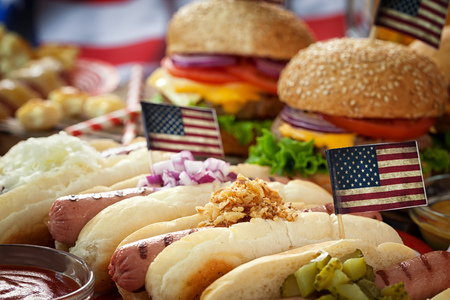
It’s nearing the height of summer, and the temperatures begin to soar. Every July 4th, around the Country, Americans often embrace Independence Day and celebrate with family traditions from around the kitchen table or barbecues.
Americans often associate the day with grilled hamburgers, hotdogs, and kids running around the backyard, with nighttime displays lighting the skies after. But do you ever wonder where these traditional foods came from? How did the hotdog and hamburger become associated with America and Independence Day? How different are they from what our founding fathers might have eaten?
We look at these traditional July 4th celebration foods and how they became synonymous with American cuisine.
The First Independence Day Meals
The food Americans ate during the times of the Founding Fathers differed significantly from what Americans are used to cooking today. The Smithsonian’s National Museum of Natural History decided to take a closer look at American History through food, particularly Independence Day foods.
On July 4th, 1776, in Philadelphia’s City Tavern, the Founding Fathers enjoyed a celebratory meal, though there is no record of the bill of sale. What sort of tavern food would have been served in an American Colonial tavern? They could have enjoyed any of the following:
- Veal or Mutton
- Beefsteak
- Green peas
- Ham or Bacon
- Pigeon, turkey, or duck
- Cheese
- Baked, fried, or boiled eggs
- Salmon, eels, oysters, and seasonal fresh or saltwater fish
Tavern fare was often limited as many kitchens cooked over an open fire, limiting options to mostly fried or boiled foods.
The Iconic Hot Dog
The hot dog is one of the most iconic 4th of July and American BBQ go-to. There are conflicting stories about where the hotdog may have originated.
Frankfurt-am-Main, in Germany, is often traditionally credited with creating the Frankfurter around 1487, five years before Christopher Columbus set sail for the New World.
Vienna, Austria, claims their term “Weiner,” as proof that Vienna is the birthplace of the hot dog.
But many claim that it was a famous sausage, known as a ‘dachshund’ or ‘little-dog’ sausage, created in the 1600s by Johann Georghehner, who invented the hotdog. Johann was a butcher who lived in Coburg, Germany, where Georghehner traveled to Frankfurt to promote this new food product.
Whichever source may or may not be true, there is one thing for sure: the hot dog as we know it in America most likely came from several European sausages brought here by immigrant butchers from several nationalities.
Who served the first ‘dachshund’ sausage on a milk roll that would eventually transition into the hotdog we know and love today? That detail is also unclear. One tells the story of a German immigrant, Charles Feltman, who opened the first Coney Island hot dog stand selling 3,684 dachshund sausages in a milk roll during his first year of business. Another story claims Harry M. Stevens, who worked at the New York Polo Grounds in 1901, came up with the idea of using small French rolls to hold sausages, which he sold when the wax paper sold out.
The hotdog reached homes around the country when it became the standard food fare at baseball parks around 1893, with the word ‘hot dog’ becoming the common term for this iconic dish around the 1890s.
Today, the hot dog, as we know, remains one of the top American foods for every occasion, including the July 4th BBQ.
The Hamburger
Besides the hotdog, the hamburger is the other iconic food Americans have embraced for a Fourth of July celebration. Whether it’s a juicy ground beef, chicken, turkey, or vegan burger, we love our burgers! It’s estimated that Americans eat around fifty million of them yearly, but how did cooked ground beef on a bun become so popular, and where did it come from?
The exact origin of placing a patty of ground beef between two slices of bread is, of course, contested. The first printed evidence of a “hamburger steak sandwich” began appearing as advertisements in United States newspapers around the 1890s.
Some attribute the American hamburger to Carlie Nagreen, Frank and Charles Menches, Oscar Weber Bilby, Fletcher Davis, or Louis Lassen, while White Castle traces the hamburger back to Hamburg, Germany, by Otto Kause. Yet another source that many point to is Hannah Glasse’s The Art of Cookery Made Plain and Easy, published in 1758, which features “Hamburgh sausages” on toasted bread.
Many food historians can agree that Fletcher Davis’ early version of the hamburger, brought to the St. Louis World’s Fair in 1904, began the American love story with the hamburger.
From there, in 1925, two men in Wichita, Kansas, opened a burger-themed restaurant called White Castle, creating the groundwork for one of the most recognizable dishes in fast food: the burger. The Rite Spot, in Pasadena, California, claims to be the first to add cheese to the burger, and The McDonald’s brothers, in 1954, pivoted from BBQ to burgers in a little burger shack in California that turned into the world’s largest fast food chain.
A Nation of Nations
Why did the hamburger, the hotdog, and frankfurters become so iconic and not some other American-named city dish? Because our country is a country of immigrants from all over the world, melding together flavors and recipes from different cultures and making them uniquely our own.
American cuisine has always been food-rooted in different countries, customs, and family traditions. Whichever family tradition you choose to continue this Fourth of July, we’re proud at Wholey to be able to provide the freshest ingredients for a celebration you and your family won’t soon forget!
Whether you’re looking for the classic T-Bone steak, the juiciest and sweetest shrimp, or something a little unusual this July, we’ll have what your taste buds need to be delivered right to your door.
We wish you a Happy Independence Day from our family to yours.

